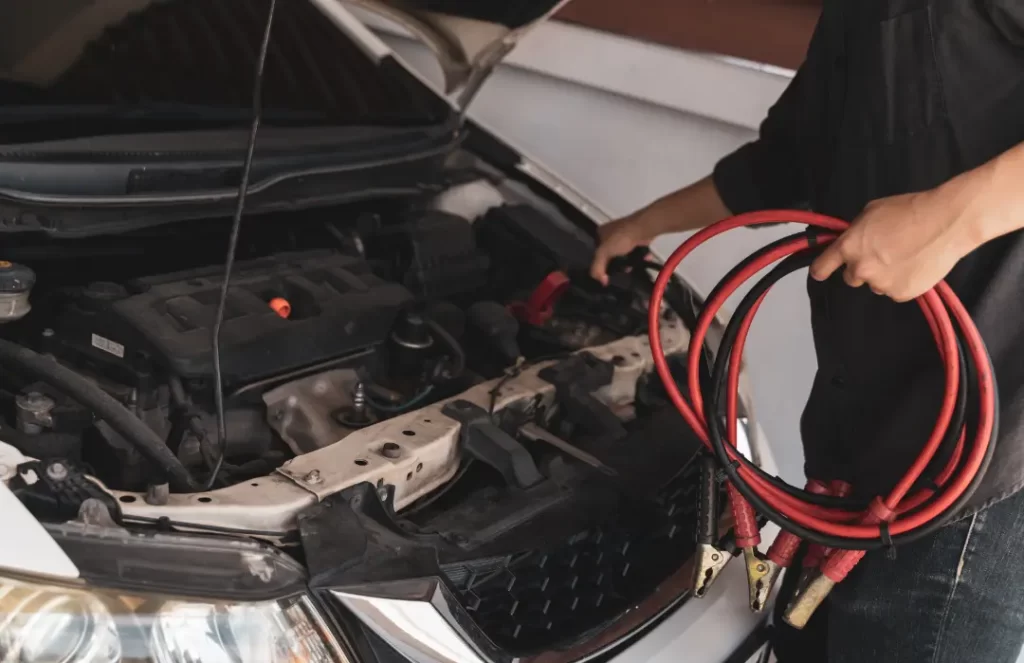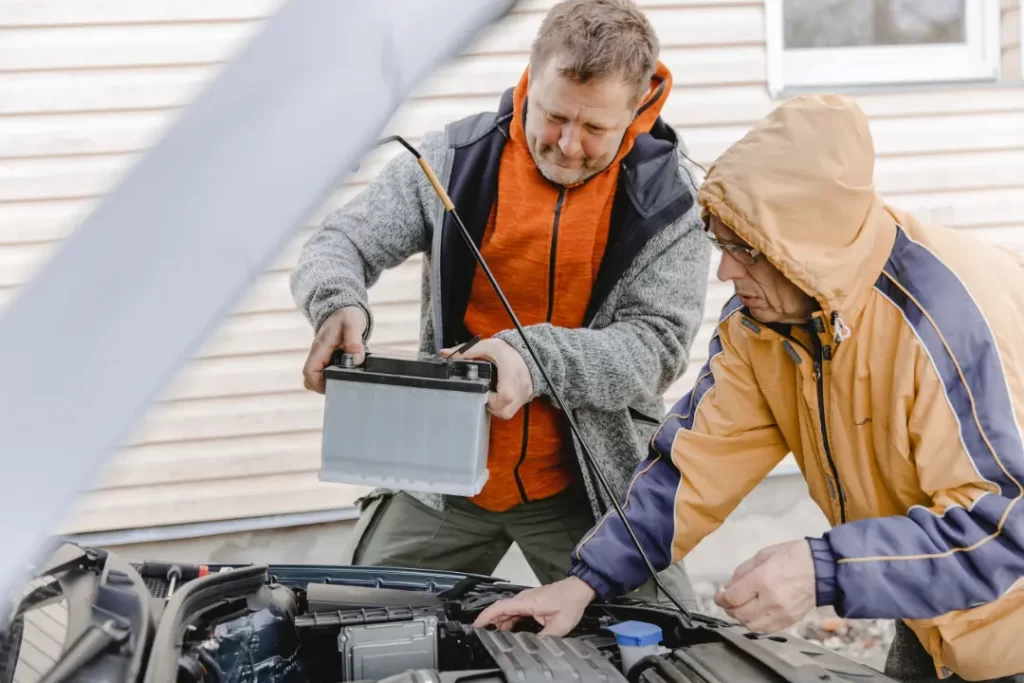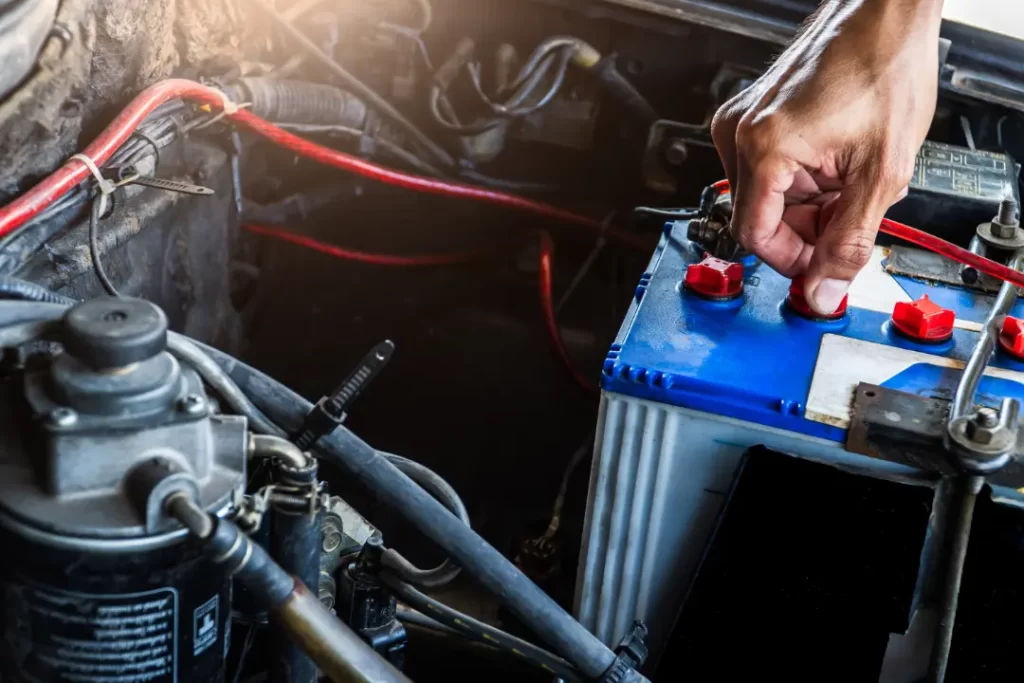How long to charge a car battery depends on several factors. Charging can take from one hour to a few days based on the charger type and battery condition. Keep reading to learn detailed information on different chargers and what affects charging times.
Key Takeaways
- Charging a car battery can take between 10 to 24 hours, significantly influenced by battery size, charger type, and battery condition.
- Different charger types—standard, trickle, and multi-stage—offer varying charging times and efficiencies, with multi-stage chargers being the fastest and most effective.
- To maintain battery health, regularly monitor voltage, choose the appropriate charger, and recharge for vehicles in storage at least once a month or every three months.
How Long Does it Take to Charge A Car Battery?
A full car battery charge can take up to 24 hours, and factors such as the battery size and charger type significantly influence the duration. A completely dead battery will take longer to recharge than a partially drained one.
Generally, the charging duration can be impacted by the type and condition of the battery and external conditions like temperature. Below, we explore charging specifics with standard, trickle, and multi-stage chargers.

Charging with a Standard Charger
A standard charger typically recharges a car battery for 4 to 8 hours. Often 12-volt, these chargers provide a steady charge and are suitable for most regular car batteries. Ensure compatibility to avoid potential damage.
Charging with a Trickle Charger
Trickle chargers charge car batteries slowly, making them ideal for maintaining long battery health. Operating at a low power level, they provide a small current over an extended period, taking two to three days to recharge a car battery fully.
Trickle chargers keep an idle battery topped up, preventing damage and extending its lifespan. However, they take a long time to charge and therefore require patience.
Charging with a Multi-Stage Charger
Multi-stage chargers are highly efficient for recharging car batteries. Using different phases optimises the process and significantly reduces charging time. A car battery can be fully recharged in as little as one hour, although it may take up to 12 hours, depending on the battery and charger type.
Multi-stage chargers speed up the charging process and ensure safe charging, reducing the risk of overcharging and prolonging the battery’s lifespan.
Factors Affecting Car Battery Charging Time
Factors such as the type of battery, charger used, and external conditions influence the time needed to charge a car battery. Understanding these can help optimise the charging process and maintain battery health.
Battery Type and Condition
The type and condition of the battery significantly impact charging time. Lead-acid batteries require a lead-acid charger, while AGM batteries need an AGM-compatible charger. Charging times can vary widely; depending on their condition, lead-acid batteries can take 4-8 hours to charge fully with a standard charger. It is essential to match the charger to the specific battery type.
Additionally, flooded batteries and AGM batteries have different charging requirements. Sulfation, reduced battery age, and physical damage, such as corrosion, can negatively affect charging efficiency. Moreover, proper voltage monitoring is critical; a battery at 12.1 volts is at 50% capacity, while 11.6 volts indicates near-complete discharge.
Charger Amperage
The charger’s amperage affects how quickly a car battery charges. Higher amperage chargers can reduce charging time but must be compatible with the battery type to avoid damage.
Smart chargers, with advanced features, enable efficient charging and better battery maintenance.
External Conditions
External conditions, such as temperature, can significantly affect charging time. On the other hand, colder temperatures can reduce battery efficiency and lead to longer durations. Charging your battery in a well-ventilated, temperature-controlled environment ensures optimal performance.
Importance of Choosing the Right Battery Charger
Choosing the right battery charger is essential for maintaining your car battery’s health and ensuring efficient charging. The main types include trickle chargers, smart battery chargers, and multi-stage chargers. Always match the charger to your specific battery type and condition for best performance.
For example, lead-acid batteries require specific chargers designed for their chemistry.

Standard vs. Smart Chargers
Standard chargers typically operate at around 4 amps, making them suitable for regularly charging car batteries over a reasonable period. Trickle chargers, on the other hand, deliver a lower, continuous charge ranging from 0.8 to 4 amps, ideal for maintaining battery health over extended periods without overcharging.
Smart chargers go a step further by offering advanced features such as automatic shut-off when the battery reaches full charge and built-in diagnostics to monitor battery condition. These features ensure optimal charging, preventing overcharging and potential battery damage.
When choosing between a standard and a smart charger, consider factors like charging speed, battery type (e.g., lead-acid, AGM), and the safety features you need, such as overcharge protection and automatic maintenance modes.
Trickle Chargers for Maintenance
Trickle chargers keep a battery topped up by providing a low charge level, making them ideal for vehicles not frequently used. Continuous, low-level charge helps maintain battery health and prevent damage during prolonged inactivity.
Multi-Stage Chargers for Efficiency
Multi-stage chargers improve charging efficiency by utilising distinct phases. They deliver power in short bursts rather than continuously, helping to manage battery heating and enhance safety during the process with a multi-stage battery charger.
By optimising the charging phases, multi-stage chargers can significantly reduce charging time compared to standard chargers, making them a preferred choice for efficient battery charging.
Steps to Safely Charge Your Car Battery
Charging a car battery safely involves several critical steps. Using a jump starter is often safer than a fast charger for reviving a flat battery, and using the right charger helps avoid permanent damage.
Properly charging a car battery is crucial for maintaining its health and longevity. Following basic car maintenance tips helps ensure that your battery remains in good condition.
Prepare the Battery
Before charging a car battery, check its condition and ensure all connections are secure. Cleaning battery terminals before charging can eliminate corrosion and improve connectivity. Charge outdoors or in a well-ventilated area, and follow safety precautions like removing jewellery and wearing gloves and safety glasses.
Connect a backup battery to the OBD-II port during charging to prevent memory loss in the car’s onboard computers. If needed, remove the battery from the vehicle to facilitate charging.
Connect the Charger
Properly connecting the charger is crucial for safety and effective charging. Always connect the positive cable to the battery terminal first, followed by the negative cable.
Ensure the cables are securely attached, and no metal parts are touching to avoid sparks.
Monitor the Charging Process
Monitoring the charging process ensures safety and optimal performance. Using a smart charger or regularly checking the battery’s condition can prevent overcharging, which can cause excessive heat, damage, and a shorter lifespan.
When to Recharge a Car Battery
Knowing when to recharge your car battery is crucial for maintaining its health. A weak battery, typically at 12.68 volts, suggests it needs recharging. Indicators include struggling to start, frequent jump-starts, dull headlights, and malfunctioning electronics.
Batteries over 4-5 years old often struggle to hold a charge and may need replacement. Frequent short trips can also drain a battery, running flat quickly, as they don’t allow it to recharge fully.
If your car is parked and unused for several days, periodically recharge it.

Can You Charge a Car Battery While Driving?
Under the right conditions, driving can effectively recharge a car battery. Driving for about 30 minutes at highway speeds helps recharge a car battery. However, higher speeds, typically 55 MPH or more, are necessary for the battery to receive a proper charge.
Nevertheless, regular driving may not fully recharge a significantly discharged battery. In such cases, a dedicated charging session using the appropriate charger is recommended.
How Often Should You Charge Your Car Battery?
Charge your car battery at least once a month, especially if it’s parked in the garage. For electric vehicles, the principle of Always Be Charging (ABC) suggests consistent charging to maintain battery health. However, you don’t need to charge your battery every time you drive to minimise unnecessary wear.
Regular driving helps prevent the battery from draining. If storing a vehicle for an extended period, charge it every three months to maintain battery health.
Regular charging is essential for maintaining your car battery’s health.
Summary
In summary, understanding the optimal methods and time needed to charge a car battery can significantly enhance your vehicle’s performance and longevity. From choosing the right charger to knowing when and how to charge it, these insights can help you maintain a fully charged car battery, ensuring your car is always ready to go.
Frequently Asked Questions
How long does it take to charge a car battery with a standard charger?
Charging a car battery with a standard charger typically takes between 4 to 8 hours. This duration may vary depending on the battery’s state of charge and the charger’s specifications.
Can you charge a car battery while driving?
Yes, driving at highway speeds for approximately 30 minutes can effectively recharge a car battery. The alternator generates power to replenish the battery while the vehicle is in motion.
What are the signs that my car battery needs recharging?
If your car struggles to start, requires frequent jump-starts, has dull headlights, or experiences malfunctioning electronic systems, it’s a clear indication that your battery may need recharging. Address these issues promptly to avoid further complications.
How often should I charge my car battery?
You should charge your car battery at least once a month, particularly if the vehicle is not used frequently. This practice helps maintain battery health and ensures reliable performance.
What is a trickle charger, and when should I use it?
A trickle charger is designed to provide a continuous, low-level charge to maintain battery health, making it ideal for vehicles that are infrequently used or stored for extended periods. You should use it when you want to prevent battery depletion and ensure optimal performance when you need the vehicle.

